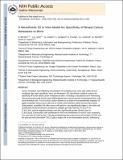A microfluidic 3D in vitro model for specificity of breast cancer metastasis to bone
Author(s)
Bersini, Simone; Dubini, Gabriele; Arrigoni, Chiara; Chung, Seok; Moretti, Matteo; Jeon, Jessie S; Charest, Joseph; Kamm, Roger Dale; ... Show more Show less
DownloadKamm_A microfluidic.pdf (3.101Mb)
PUBLISHER_CC
Publisher with Creative Commons License
Creative Commons Attribution
Terms of use
Metadata
Show full item recordAbstract
Cancer metastases arise following extravasation of circulating tumor cells with certain tumors exhibiting high organ specificity. Here, we developed a 3D microfluidic model to analyze the specificity of human breast cancer metastases to bone, recreating a vascularized osteo-cell conditioned microenvironment with human osteo-differentiated bone marrow-derived mesenchymal stem cells and endothelial cells. The tri-culture system allowed us to study the transendothelial migration of highly metastatic breast cancer cells and to monitor their behavior within the bone-like matrix. Extravasation, quantified 24 h after cancer cell injection, was significantly higher in the osteo-cell conditioned microenvironment compared to collagen gel-only matrices (77.5 ± 3.7% vs. 37.6 ± 7.3%), and the migration distance was also significantly greater (50.8 ± 6.2 μm vs. 31.8 ± 5.0 μm). Extravasated cells proliferated to form micrometastases of various sizes containing 4 to more than 60 cells by day 5. We demonstrated that the breast cancer cell receptor CXCR2 and the bone-secreted chemokine CXCL5 play a major role in the extravasation process, influencing extravasation rate and traveled distance. Our study provides novel 3D in vitro quantitative data on extravasation and micrometastasis generation of breast cancer cells within a bone-like microenvironment and demonstrates the potential value of microfluidic systems to better understand cancer biology and screen for new therapeutics.
Date issued
2013-12Department
Charles Stark Draper Laboratory; Massachusetts Institute of Technology. Department of Biological Engineering; Massachusetts Institute of Technology. Department of Mechanical EngineeringJournal
Biomaterials
Publisher
Elsevier
Citation
Bersini, Simone, Jessie S. Jeon, Gabriele Dubini, Chiara Arrigoni, Seok Chung, Joseph L. Charest, Matteo Moretti, and Roger D. Kamm. “A Microfluidic 3D in Vitro Model for Specificity of Breast Cancer Metastasis to Bone.” Biomaterials 35, no. 8 (March 2014): 2454–2461.
Version: Author's final manuscript
ISSN
01429612